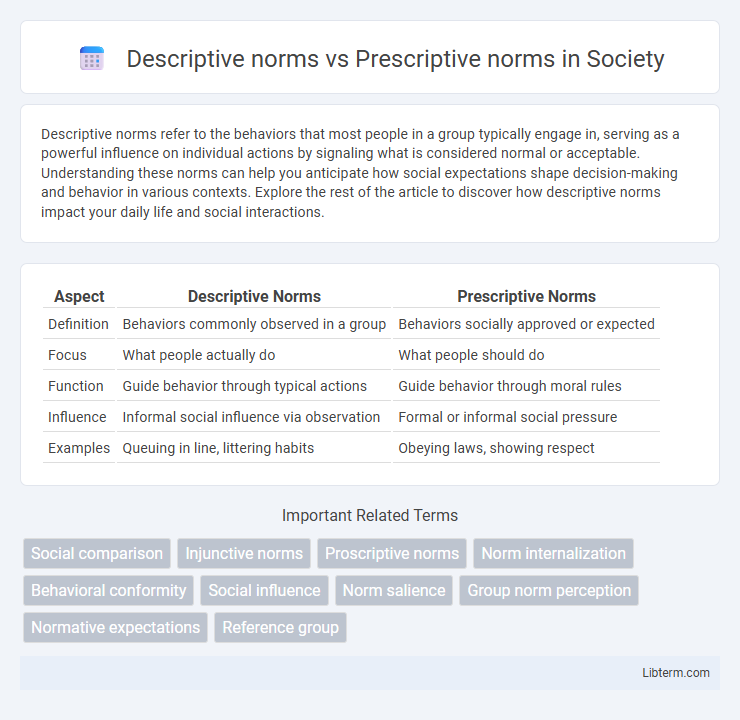Descriptive norms refer to the behaviors that most people in a group typically engage in, serving as a powerful influence on individual actions by signaling what is considered normal or acceptable. Understanding these norms can help you anticipate how social expectations shape decision-making and behavior in various contexts. Explore the rest of the article to discover how descriptive norms impact your daily life and social interactions.
Table of Comparison
| Aspect | Descriptive Norms | Prescriptive Norms |
|---|---|---|
| Definition | Behaviors commonly observed in a group | Behaviors socially approved or expected |
| Focus | What people actually do | What people should do |
| Function | Guide behavior through typical actions | Guide behavior through moral rules |
| Influence | Informal social influence via observation | Formal or informal social pressure |
| Examples | Queuing in line, littering habits | Obeying laws, showing respect |
Understanding Descriptive Norms
Descriptive norms refer to perceptions of what is commonly done in a specific social group, guiding behavior based on observed actions rather than explicit rules. Understanding descriptive norms helps explain why individuals conform to behaviors perceived as typical or widespread, influencing choices through social proof and shared expectations. These norms shape social behavior by signaling what is normal and acceptable within a community, affecting attitudes and decision-making processes.
Defining Prescriptive Norms
Prescriptive norms, also known as injunctive norms, define behaviors that are socially approved or disapproved, guiding individuals on what they ought to do. These norms function as moral rules or standards, motivating compliance through anticipated rewards or sanctions. Understanding prescriptive norms is essential for analyzing social influence, conformity, and the maintenance of cultural values within groups.
Key Differences Between Descriptive and Prescriptive Norms
Descriptive norms refer to perceptions of how people typically behave in a given situation, while prescriptive norms dictate how people should behave according to societal rules or expectations. Descriptive norms are based on observed behaviors, highlighting common practices, whereas prescriptive norms involve moral judgments or obligations guiding appropriate conduct. Understanding the distinction is crucial for fields like social psychology, marketing, and behavioral change interventions, as descriptive norms influence conformity through imitation, and prescriptive norms drive compliance through social approval or sanctions.
The Role of Social Influence in Norm Formation
Descriptive norms refer to perceptions of what behaviors are typically performed by others, guiding individuals through observations of common actions within a group. Prescriptive norms involve beliefs about what behaviors are socially approved or disapproved, shaping actions based on moral judgments and expectations. Social influence plays a crucial role in norm formation by reinforcing conformity through observational learning and social sanctions, helping groups establish shared standards for acceptable behavior.
Examples of Descriptive Norms in Everyday Life
Descriptive norms refer to perceptions of how people commonly behave in specific situations, such as littering being rare in communities with clean streets or most people recycling their waste. Examples include observing that the majority of commuters use public transportation during rush hour or noticing that many employees casually dress in business casual attire at the office. These norms influence behavior by signaling what is typical, shaping individuals' actions based on what others are doing rather than what they ought to do.
Examples of Prescriptive Norms in Different Cultures
Prescriptive norms guide behavior by specifying what individuals should or should not do, such as removing shoes before entering a home in Japan or addressing elders with formal titles in India. In Middle Eastern cultures, offering guests tea or coffee is a prescriptive norm symbolizing hospitality, while in Western countries, queuing orderly in public places reflects social expectations. These norms shape daily interactions by establishing culturally specific standards for respectful and appropriate conduct.
Effects of Descriptive Norms on Behavior
Descriptive norms significantly influence behavior by informing individuals about what is commonly done in a specific context, thereby guiding their actions through perceived social acceptance. Research indicates that people are more likely to conform to behaviors exhibited by the majority, as seen in energy conservation studies where individuals reduced consumption upon learning neighbors' usage patterns. This normative influence operates through social proof, enhancing motivation to align with typical behaviors to gain social approval or avoid exclusion.
Impacts of Prescriptive Norms on Society
Prescriptive norms establish societal expectations and dictate acceptable behaviors, significantly influencing social order and cohesion. These norms shape ethical standards, guide legal frameworks, and promote conformity, thereby reducing social conflicts and enhancing collective well-being. Enforcing prescriptive norms also fosters accountability and responsibility, contributing to the stability and predictability essential for community development.
Interplay Between Descriptive and Prescriptive Norms
Descriptive norms reflect how people typically behave in a given context, while prescriptive norms indicate how people ought to behave according to social expectations. The interplay between descriptive and prescriptive norms shapes individual decision-making, as people often align their actions with prevailing behaviors but also consider moral or societal rules. Conflicts arise when descriptive norms diverge from prescriptive norms, influencing social conformity and ethical judgments in various settings.
Practical Implications for Policy and Communication
Descriptive norms, which reflect what most people actually do, can effectively guide policies aimed at behavior change by leveraging the power of social proof to encourage compliance. Prescriptive norms, indicating what people ought to do, are critical in shaping moral and ethical expectations within communication strategies to foster social approval and accountability. Policymakers and communicators should combine these norms to design interventions that both motivate action through observed behaviors and reinforce desired standards through explicit guidance.
Descriptive norms Infographic

 libterm.com
libterm.com